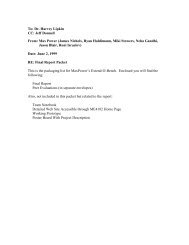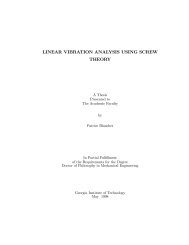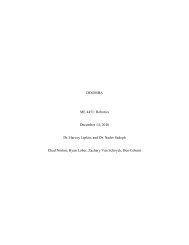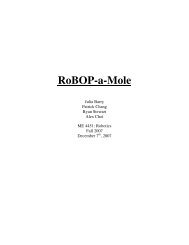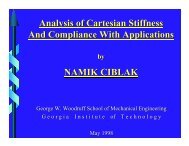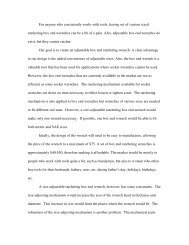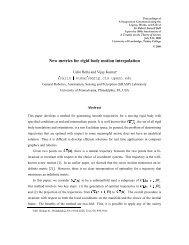Now for equilibrium this must vanish for arbitrary S. Hence we must separate out S,todo this look at the term,( ) (ω × (Rbi + t)+v −RBi RSM ˜b i ==T )− T I 3 ω00 0)(vwhere I 3 is the 3 × 3 identity matrix and B i is the anti-symmetric matrix correspond<strong>in</strong>gto b i .If we substitute this <strong>in</strong>to the equilibrium equation and use the fact that S and thusω and v are arbitrary, we get,() T −RBi R∑λ i(ãi − M ˜b T )− T I 3i = 00 0iAfter a little manipulation, this matrix equation produces 2 vector equations,∑λ i a i × (a i − Rb i − t)=0 (1)iand∑λ i (a i − Rb i − t)=0 (2)iIf the weights λ i are all equal, then equation 2 tells us that the optimal transformationmaps the centroids of the a po<strong>in</strong>ts to the b po<strong>in</strong>ts. Another way of putt<strong>in</strong>g this is that atan equilibrium configuration the centroids of the two sets of po<strong>in</strong>ts must co<strong>in</strong>cide. Toproceed, we choose the orig<strong>in</strong> of coord<strong>in</strong>ates so that the centroid of the b po<strong>in</strong>ts lies atthe orig<strong>in</strong>, ∑ i λ i b i = 0. The translation vector is now given by equation (2) as,t = ∑ i λ i a i∑ i λ iIn the above form equation (1) is not very easy to deal with, a more tractable form isthe 3 × 3 representation. A small computation confirms that the anti-symmetric matrixcorrespond<strong>in</strong>g to a vector product p×q,isgivenbyqp T −pq T . Hence <strong>in</strong> this form theequation becomes,(∑λ i Rbi a T i − a i b T i R T ) = 0iNow, writ<strong>in</strong>g, P = ∑ i λ i a i b T i and us<strong>in</strong>g the result that t = ∑ i λ i a i /∑ i λ i , this equationbecomes;RP T = PR T (3)This shows that the matrix PR T is symmetric. So let us write PR T = Q where Q issymmetric, then we have that,P = QRThis decomposes the matrix P as the product of a symmetric matrix with a properorthogonal one. This is, essentially the polar decomposition of the of the matrix. Noticethat the polar decomposition P = RQ ′ also satisfies the equation, the rotation matrix Rhere is the same as above but the symmetric matrix Q ′ = R T QR is simply congruentto the orig<strong>in</strong>al symmetric matrix. So as far as the solution for R is concerned there isno difference between these solutions. In fact the polar decomposition of a matrix is3
<strong>in</strong>to an orthogonal matrix and a non-negative symmetric matrix. But here we want aproper orthogonal matrix and a symmetric one. If the orthogonal matrix from the polardecomposition of P is a reflection then we can simply multiply by −1 to get a rotation.More details on the polar decomposition of a matrix can be found <strong>in</strong> [6], for example.The polar decomposition give one solution, but this solution is not unique. LetP = QR p be the polar decomposition of P, now substitute this <strong>in</strong>to the equation (3),RR T p QP T = QR p R TIf we write R i = RR T p then the equation becomes,R i QR i = QSuppose that v lies <strong>in</strong> the direction of the rotation axis of R i , so that R i v = v, postmultiply<strong>in</strong>gthe above equation by v gives,R i Qv = QvHence Qv lies along the axis of R i and we can write,Qv = µvfor some constant µ. Any solution for the rotation R i must have its axis of rotationaligned with an eigenvector of Q.The possible angles of rotation can be found by consider<strong>in</strong>g the action on the eigenvectorsof Q, us<strong>in</strong>g the fact that the eigenvectors of a symmetric matrix are mutuallyorthogonal. If the matrix P is non-s<strong>in</strong>gular then it is well known that the polar decompositionis unique. If the eigenvalues of Q are all different and also have differentmagnitudes then the only possible angles are 0 and π. This gives four solutions <strong>in</strong> all,R i = I 3 is the solution we found above, that is R is simply the rotation from the polardecomposition. The three other solutions for R i are rotations of π radians about thethree eigenvectors of Q. So <strong>in</strong> all we have four solutions R = R p R i , where R p is therotation from the polar decomposition of P and R i are as above, rotations of π about theith eigenvector of Q, the fourth solution is given by R 0 = I 3 . Notice that there four rotationsform a discrete subgroup of the group of rotation, this subgroup is the symmetrygroup of the octahedron.If any of the above conditions is broken, P is s<strong>in</strong>gular, two of the eigenvalues ofQ are equal, or a pair of eigenvalues sum to zero, then we get more solutions. Forexample, if a pair of eigenvalues of Q sum to zero then any rotation about the rema<strong>in</strong><strong>in</strong>geigenvector will satisfy the equation for R i .The fact that, <strong>in</strong> the general case, we have found four stationary po<strong>in</strong>ts of the potentialenergy function is not surpris<strong>in</strong>g. Morse theory studies the relationship betweenmanifolds and the critical po<strong>in</strong>ts of functions def<strong>in</strong>ed on them, see [9]. The criticalpo<strong>in</strong>ts, or stationary po<strong>in</strong>ts here, correspond to cells <strong>in</strong> a cellular decomposition of themanifold. The manifold <strong>in</strong> question here is the underly<strong>in</strong>g manifold of the rotationgroup SO(3), this is known to be 3-dimensional projective space, IRIP 3 . The m<strong>in</strong>imalcellular decomposition of IRIP 3 has for cells, with dimensions 0, 1, 2 and 3 see [3, p.105]. Hence, we expect a m<strong>in</strong>imum of 4 critical po<strong>in</strong>t for function on SO(3). Moreover,<strong>in</strong>dex of the critical po<strong>in</strong>t, the number of negative eigenvalues of its Hessian4





